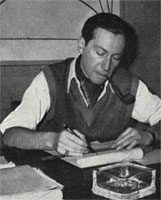
 Born in Lisieux on April 5, 1918, Jacques Quinet, after starting his studies in architecture, was mobilized in 1940. Since 1946, he has devoted himself definitively to interior architecture and decoration. Starting in 1947, he participated in Art and Industry exhibitions, from the Siège to the Pavillon de Marsan, the Salon des Artistes Décorateurs, and in the following years, various events in France and abroad. In 1954, he was commissioned by the Ministry of Merchant Marine to organize France's participation in the International Exhibition of Navigation in Naples, where his works were awarded an honorary diploma.In 1950, the Compagnie des Messageries Maritimes entrusted him with the architecture of the ocean liner "La Bourdonnais," and in 1954, the cargo ships "Godavery" and "Moonie."
Born in Lisieux on April 5, 1918, Jacques Quinet, after starting his studies in architecture, was mobilized in 1940. Since 1946, he has devoted himself definitively to interior architecture and decoration. Starting in 1947, he participated in Art and Industry exhibitions, from the Siège to the Pavillon de Marsan, the Salon des Artistes Décorateurs, and in the following years, various events in France and abroad. In 1954, he was commissioned by the Ministry of Merchant Marine to organize France's participation in the International Exhibition of Navigation in Naples, where his works were awarded an honorary diploma.In 1950, the Compagnie des Messageries Maritimes entrusted him with the architecture of the ocean liner "La Bourdonnais," and in 1954, the cargo ships "Godavery" and "Moonie."
He carried out significant projects for the headquarters on Rue de Varenne, and for the Bouchet Center of Atomic Energy, as well as offices for one of the delegates of the O.E.C.E. He also worked on holiday camps in Oye Plage and Saint Cergues les Voirons for the Société Louvroil Montbard Aulnoye, and on the polychrome and interior architecture of the Société des Eaux d'Evian.
In collaboration with the architect Louis Aublet, he designed the headquarters of Potasses d'Alsace in Paris, and with architect Novarina, the new theater in Evian, the polychrome of collective buildings in Pont Audemer, and the School of Illeville. With Novarina again, he worked on the interior decoration of the church in Alby sous Chéran, and in collaboration with Bazaine, Ubac, and Chagall, on the Church of Villeparisis.
In addition to his role as an interior architect and decorator in significant projects where issues of color and its functional role play a major part, Jacques Quinet also organized the furnishing of numerous private installations in France, America, and Iran, with a particular interest in furniture.
He appreciates fine cabinetry and strives to give his furniture harmony of rhythm and volume, as well as refined ornamental decorations in sculpted or chiseled bronze, following the classical tradition.
Two of his furniture pieces, a sideboard entirely lined with chamois internally and a chest of drawers, both made of sycamore, were acquired by the Mobilier National. Although he once considered studying models of furniture for mass production, Jacques Quinet's taste leans towards luxury furniture. He enjoys working with light, delicate, and silky woods, and gladly uses Cuban mahogany while also exploring smooth and dignified lacquer coatings to achieve precious textural effects.
When collaborating with architects who design homes according to aesthetics and habits characteristic of new lifestyles, Jacques Quinet remains faithful to the constructive principles he considers essential and from which he has no intention of deviating as sources of inspiration. However, he submits to the influence of this architectural order, which is both functional and austere, demanding logical and emotional relationships with the furniture.
This has led him to conceive his furniture ensembles with greater rigor and freedom, while preserving a decorative character for the beauty of the materials and technical refinements, which ornamentation can no longer assume.
Sources : Mobilier et Decoration N°1 Fevrier 1955